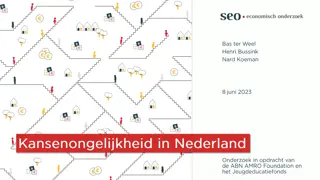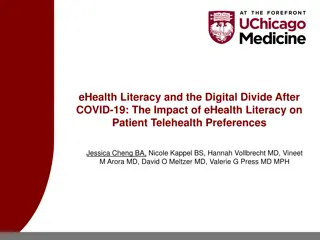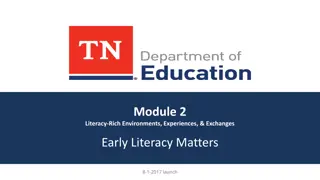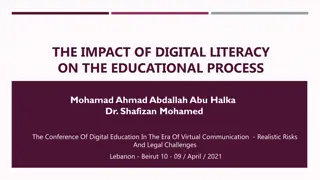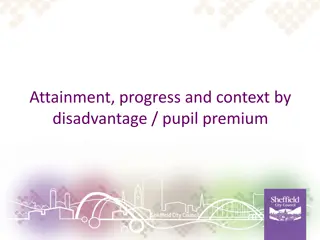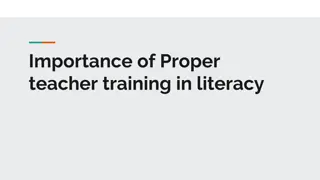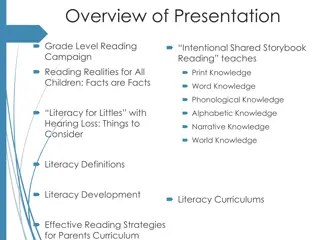Digital Literacy Challenges Among Children Living in Socioeconomic Disadvantaged Areas
This study focuses on the digital literacy challenges faced by children living in Pusat Perumahan Rakyat (PPR) and proposes inclusive initiatives to enhance their digital skills. The research investigates the level of digital media adoption, essential literacy areas, and needed skills. Despite basic operational skills, these children lack productive utilization of digital tools due to limited access and training.
Download Presentation

Please find below an Image/Link to download the presentation.
The content on the website is provided AS IS for your information and personal use only. It may not be sold, licensed, or shared on other websites without obtaining consent from the author.If you encounter any issues during the download, it is possible that the publisher has removed the file from their server.
You are allowed to download the files provided on this website for personal or commercial use, subject to the condition that they are used lawfully. All files are the property of their respective owners.
The content on the website is provided AS IS for your information and personal use only. It may not be sold, licensed, or shared on other websites without obtaining consent from the author.
E N D
Presentation Transcript
Poverty and Digital Literacy: A study on Children Living at the Pusat Perumahan Rakyat (PPR) LEAD RESEARCHER: Dr. Shafizan Mohamed (IIUM) RESEARCH MEMBERS: Professor Saodah Wok (IIUM) Dr. Wan Norshira Wan Ghazali (IIUM) Dr. Nur Shakira Mohd. Nasir (IIUM)
Research Problem Digital Literacy of the B-40 The Malaysian government projected that by 2030, Malaysia will become a developed country. Communications and Multimedia Blueprint (CMB) 2018-2025 Education Blueprint 2013-2025 Children living at the Pusat Perumahan Rakyat (PPR) is a segment of the B40 that could be left behind by the government s progressive policies if they are not given the right guidance and worldviews to be a part of a developed Malaysia. Digital technology is a powerful tool that can facilitate these children into becoming active citizens. These children need to be provided with the right combination of digital access and digital literacy.
Formulate inclusive initiatives and strategies that will cater to the needs of children who are socioeconomically challenged. Provide a holistic insight into how digital literacy programs can be prioritized in relevant policy-based and community-based digitization programs. The research investigated: 1.level of digital media adoption and use 2.digital media literacy areas and skills most required (operational, security, participation and content creation) Research Objectives
Theoretical Framework: DigComp Digital Competency Methodology 1. Informational and operational skills 2. Safety and security 3. Communication and Participation 4. Content creation and digital innovation 5. Problem-solving skills 308 children living at PPR Desa Rejang, PPR Sungai Bonus and PPR Kota Damansara Phone Survey Focus Group Interviews January - March 2021
01 Children Of PPR Have Limited Ways To Access Digital Devices And The Internet.
02 The children that have access to digital technologies do not seem to have better literacy when compared to the children that do not have the access 100% 75% Tablets 9% 50% Notebook/computers 14.8% 25% 0% Smartphones 76.2% Online class Youtube Gaming
03 The children have the basic skills to operate and manage digital devices but are not technically able to productively exploit the digital media hence they have minimal digital literacy
Recommendations Leverage on existing community programs Need for an enhanced multi-stakeholder partnership Equip campaign or program that focuses on digital penetration with simple modules and guides simple brochures and attractive youtube videos Focus on the potential strengthened partnerships with more child-specific educational and training programs more innovative collaborations with the arts and gaming communities Strategic collaboration with emerging tech start-ups More children-focused activities at the Pusat Internet Komuniti Awareness raising and advocacy initiatives to highlight the importance of digital parenting Tailor programs to the needs of the community it represents. Strategically market programs to the intended audience Exploit social media platforms Collaborate with resident association Awareness-raising and advocacy campaigns to emphasize the value of digital parenting Digital safety campaigns and digital parenting modules should aim at building digitally resilient children Family digital use
The children at the PPR, like most children in today's world, have become digital by default in that they are easily exposed to the digital world despite having limited resources and devices. The danger that these children face is that they are engaging in a digital world that is full of possibilities without proper knowledge and skills. Going into this world blindly can be detrimental. Therefore, it is important that the children be armed with enough skills that can help them manoeuvre through the digital world safely and successfully.





